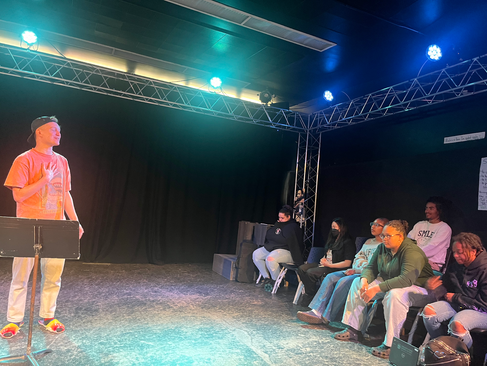Public learning in Capstone Learning and Teaching
- Convening Storytelling Team
- Sep 25, 2024
- 4 min read
This May, several teachers from all over the country squeezed into an Oakland classroom that was packed with students, family members, teachers, and school alumni, to hear an Arise High School Senior who shone with confidence as she shared her learning journey in her Capstone presentation. “Sonia” traced her path from a shy 15 year old who was afraid to ask questions, reach out to people, or explore, to a person with a thriving flower business, about to go to college, who emphasizes her love for her family as well as her leadership skills as important strengths she brings to the world.
Along with the other educators attending this site visit as part of the Assessment for Learning conference, I loved being in space with so many people listening intently to a young person – both people who know her and love her and people like me who were meeting her for the first time. Not only was Sonia celebrated, she was also asked to engage with others’ questions and noticings that brought out underlying patterns and emphases in her story, in an affirming way. This kind of dialogue feels like a necessary antidote to the ignoring, dismissing, and belittling of young people’s voices that prevails in so many communities.
At my school community of Skyline High School, a few miles away from Arise, where I am a Pathway Coach, we had also been immersed in May Capstone presentations, which is an Oakland Unified School District requirement. This was our second year of trying out a different Capstone presentation format, which relates to the public learning component of the Culminating Performance Assessment (CPA) Tool. Instead of having Seniors present their projects to a few teachers after school, we have been scheduling their presentations into classes with younger students, so that there is a more authentic audience for the presentations, with more of a focus on student-student exchange than on teacher evaluation. Students are teaching one another about issues and solutions on a myriad of topics like teen mental health, LGBTQ student rights, environmental justice, and gun violence. Seniors are demonstrating mastery in areas that matter to them. Younger students are seeing examples of what they will be doing as Seniors. Host teachers have been impressed by the thoughtful engagement of their students, who often had more to say in response to these presentations than they usually do in class. The pictures shown here are examples of such dialogue from the Performing Arts Capstone class presentations.
I have been learning more about the importance of student talk in academic growth and student outcomes, in preparation for OUSD’s district-wide focus on student talk in the coming school year. Teachers who support students’ capstone projects have been thinking about how to integrate student talk more deeply into the capstone research, analysis, writing, social action, and presentation components of capstone. They have also been interested in how to improve the interview with an expert component of the capstone project to connect student talk more explicitly to practices of relationship building in the communities beyond school.
At the AFL conference, conversations with colleagues at my table centered on how we create belonging in our schools, so that all young people feel affirmed in who they are, where they come from, and what they aspire to in their lives. We talked about the importance of students engaging with more adults than their teachers and parents, both to widen professional networks and prepare for life beyond high school but also as part of students learning to create a stronger web of support around them.

We also talked about adult dialogue in schools. This includes more intentional community building with our students’ families. It also includes collegial relationships. How do we engage with one another not only in easy moments of connection but more importantly how do we listen and respond when we are rushed, stressed, and overwhelmed by pressures beyond our scope? How do we nurture belonging in schools for one another, when we often feel isolated and forced to compete for scarce resources? How can the ways we relate to one another counter the violence of systemic disinvestment in our public schools? My colleague, Drama teacher Awele (Ah-WAY-lay) Makeba sketched out an amazing visual to organize the forces she sees at play in transformational relationships. She emphasized practices of deep listening, self-awareness, and critical consciousness as cornerstones of healthy communication, that adults need to not only support in young people but also to engage ourselves.
Much-needed space and time for reflection helped us to identify a vital area of teacher sustainability and growth. So, as I look forward to the upcoming school year, my focus for Capstone will be on strengthening public learning through creating more supports for student talk, and, at the same time, planning for an adult layer of public learning – healthy communication within the professional learning communities organized around our students.
Storyteller

Shanti Elliott
Educator
Shanti Elliott is an educator, activist, and writer. She is the Linked Learning Pathway Coach at Skyline High School in Oakland, supporting teachers and students to connect classroom learning with real world applications.
Before moving to Oakland, Shanti worked in Chicago schools for 20 years, teaching English and leading civic engagement, she also taught in the School of Education and Social Policy at Northwestern University.
Shanti's work focuses on education for social change, through community-school partnerships, anti-racism pedagogy, and broadening political awareness. Shanti has written for a wide range of publications, from Folklore Forum to The Slavic Review to Schools Journal. Her book, Teaching and learning on the verge: Democratic education in action, was published by Teachers College Press in 2015.




Bình luận